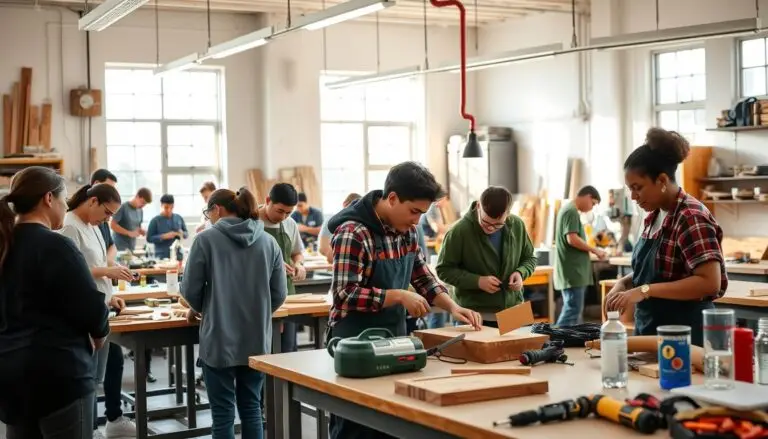From Classroom to Career: How Vocational Education and Trade Schools Prepare You for Success
From Classroom to Career: How Vocational Education and Trade Schools Prepare You for Success
In today’s fast-changing job market, finding a fulfilling and stable career path is not easy. Vocational education and trade schools are becoming key alternatives to traditional four-year colleges. They give students the practical skills and real-world experience needed for success in skilled trades and technical fields.
These schools bridge the gap between learning and working life. They are crucial in filling the skills gap and getting the next generation ready for the workforce. With curricula focused on the industry and real-world training, they help students turn their skills and interests into promising careers in fast-growing fields.
Key Takeaways
- Vocational education and trade schools offer hands-on training for in-demand skilled trades and technical careers.
- These programs give students practical skills and experience, making it easier to move from school to work.
- Vocational and trade schools are key in solving the skills gap and preparing a skilled workforce for today’s jobs.
- Graduates often earn more and have less student debt than those from traditional four-year colleges.
- Careers in skilled trades and technical fields offer stability, growth, and the chance to apply your skills in real ways.
The Rise of Vocational Education and Trade Schools
In recent years, vocational education and trade schools have seen a big comeback. Employers are looking for skilled workers in fields like construction, manufacturing, healthcare, and technology. These programs offer specific, hands-on training that meets the needs of local job markets. They prepare students for careers in skilled trades and technical fields.
Addressing the Skills Gap in Today’s Workforce
The job market is changing fast, and employers are finding a big skills gap. They can’t find workers with the skills they need. Vocational programs and trade schools are stepping up. They offer focused education and training that gives students the skills employers want.
Hands-on Training for In-Demand Careers
Vocational and trade schools focus on practical, hands-on learning. This lets students gain real skills for their chosen careers. It means graduates are ready to start working and fill the demand for skilled workers.
| Industry | In-Demand Careers | Relevant Vocational/Trade Programs |
|---|---|---|
| Construction | Electricians, Plumbers, HVAC Technicians, Carpenters | Electrical Technology, Plumbing, HVAC, Carpentry |
| Healthcare | Medical Assistants, Dental Hygienists, Pharmacy Technicians | Medical Assisting, Dental Hygiene, Pharmacy Technology |
| Manufacturing | Welders, Machinists, Industrial Maintenance Technicians | Welding, Machine Tool Technology, Industrial Maintenance |
“Vocational education and trade schools are playing a crucial role in preparing the next generation of skilled workers, addressing the evolving needs of industries and the growing skills gap in the workforce.”
Benefits of Attending a Vocational or Trade School
Going to a vocational or trade school can really open doors for you. These schools focus on preparing you for specific careers. They give you a unique way to learn that prepares you well for many in-demand jobs.
One big plus of vocational school is the focus on practical training. You don’t just sit in class all day. You get to apply what you learn in labs, internships, and real-world situations. This way, you get the skills you need for your future job.
Another big benefit is the help you get finding a job after school. Many of these schools work closely with employers. They set up internships and help graduates get hired right away. This makes moving from school to work easier, giving you a boost in your career-focused education.
These schools are also more affordable than four-year colleges. This makes getting a good education possible for more people.
“Attending a vocational or trade school is an excellent way to gain the practical, hands-on skills that employers are seeking in today’s job market.”
In short, there are many good reasons to choose a vocational or trade school. From learning by doing to getting help finding a job and saving money, these schools offer a great way to start a rewarding career.
Career Pathways in Skilled Trades and Technical Fields
Vocational education and trade schools offer many chances for those looking for rewarding careers. They cover areas like automotive, transportation, construction, and building. These programs give the hands-on training and certifications needed for in-demand jobs.
Automotive and Transportation Trades
If you love vehicles and transportation, vocational education in automotive and transportation trades is for you. You can learn to be an automotive technician, diesel mechanic, or heavy equipment operator. These programs focus on practical learning. They prepare you with the skills and certifications for the fast-paced automotive and transportation world.
Construction and Building Trades
The construction and building trades have many opportunities for skilled careers. Vocational programs in this area can turn you into electricians, plumbers, HVAC specialists, carpenters, and more. You’ll learn the latest techniques and technologies. This prepares you to help build and maintain our environment.
Vocational education and trade schools offer a direct way to in-demand, high-paying careers in various skilled trades and technical fields. They provide a focused, practical education. This helps individuals reach their career goals and support important industries.
From Classroom to Career: How Vocational Education and Trade Schools Prepare You
Vocational education and trade schools connect the classroom to the real world. They mix theory with practical training. This prepares students for their careers with the skills and experience they need.
Through partnerships with industries and apprenticeships, students get ahead. They learn in-demand skills and make important connections in their fields.
Vocational and trade schools focus on making students job-ready. They offer programs in areas like automotive, transportation, construction, and building. These programs give students the knowledge and skills needed for success in various skilled jobs.
What makes these schools stand out is their focus on practical training and working closely with industries. Students learn both the theory and the hands-on skills employers want. This prepares them to start working right away, ready to add value from the first day.
FAQ
What is the purpose of vocational education and trade schools?
Vocational education and trade schools help students move from the classroom to the workplace. They give students the skills and experience needed for in-demand careers. These schools focus on practical training and curricula that match industry needs.
How do vocational education and trade schools address the skills gap in today’s workforce?
These schools are becoming more popular as employers look to fill skills gaps in areas like construction, manufacturing, healthcare, and technology. They offer specific, hands-on training that meets the needs of local job markets. This prepares students for careers in skilled trades and technical fields.
What are the benefits of attending a vocational or trade school?
Going to a vocational or trade school has many advantages. Students get practical, career-focused courses and hands-on learning. They also have a good chance of finding a job after graduation. Plus, these schools are often cheaper than four-year colleges, making them a smart choice for a quick career start.
What are the career pathways available through vocational education and trade schools?
Vocational education and trade schools offer many career paths in skilled trades and technical fields. Students can learn about automotive, construction, and more. These programs give students the training and certifications needed for jobs like automotive technicians, electricians, plumbers, and HVAC specialists.
How do vocational education and trade schools prepare students for the transition from the classroom to their careers?
These schools mix classroom learning with practical training for a smooth move to the workforce. They work with local employers and offer apprenticeships. This gives students real-world experience and the skills to succeed in their careers.




